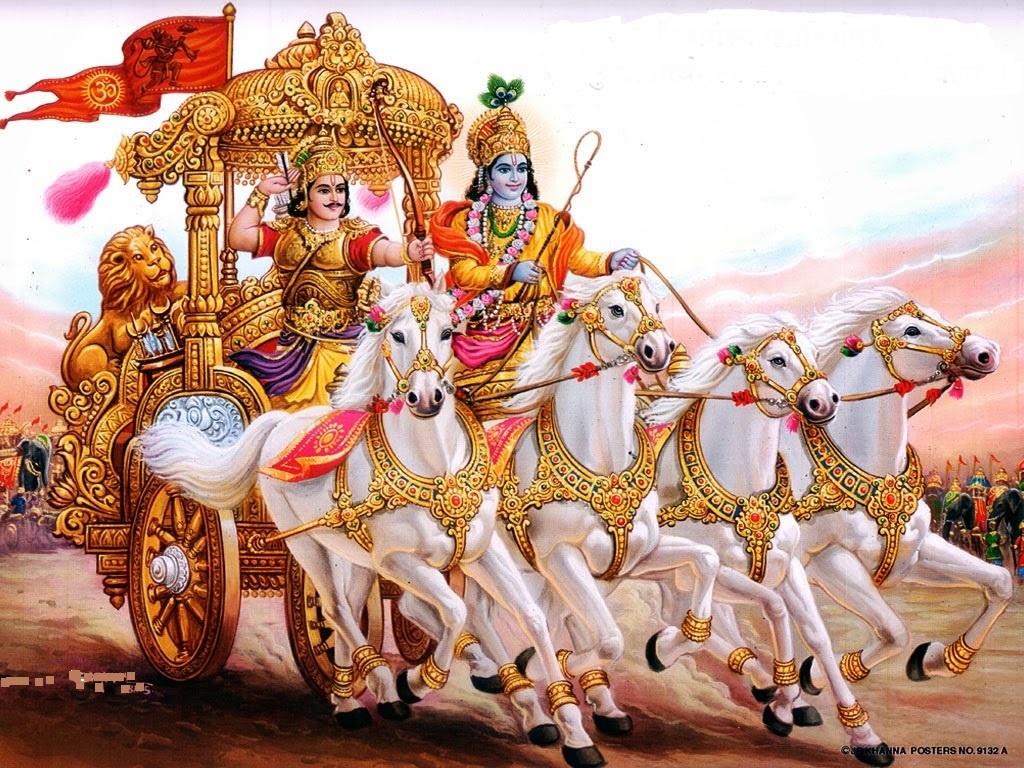The Spiritual Import of the Mahabharata and the Bhagavadgita : Ch-4. Part-1.
4: The Cosmic Manifestation : 1.
The turmoil in the mind of Arjuna, described in the first chapter of the Bhagavadgita, is attributed by Bhagavan Sri Krishna to an absence of correct understanding. Every sorrow which sinks the heart is regarded, in the light of higher thinking, as a consequence of inadequate knowledge. Man is not born to suffer; it is joy that is his birthright. It is hammered into our minds again and again that our essential nature is not grief, and therefore to manifest grief cannot be the manifestation of our essential nature. Sorrow is not our birthright; it does not belong to our true substance. What we are really made of is not capable of being affected by sorrow of any kind. There is a deep quintessence in the heart of every person which defies contamination by sorrow of every type. Hence, the great point made out by Bhagavan Sri Krishna is that the sorrow of Arjuna is unbecoming of the knowledge that would be expected of a person of his kind. What is this knowledge that we are lacking, whose absence is the source of our sorrows? Whatever be the nature of sorrow, it is just sorrow—a kind of agony that the individual feels.
This sorrow is due to a lack of knowledge of samkhya, says the second chapter of the Gita. Samkhya is correct understanding. This Arjuna did not have; therefore he was grieving. There is a necessity for enlightening the buddhi or intellect with the wisdom of the Samkhya philosophy. In the ancient Indian system of thinking, samkhya has been considered as knowledge of reality. Knowledge of things as they are is called samkhya. What is this word samkhya? We may have heard words like samkhyatikari in governmental circles. The Auditor General or the chief of the statistics department is called samkhyatikari. Samkhya is a number, calculation, counting, categorising, etc. Perhaps the word samkhya has come from the fact of its having been based on the categories of the items involved in the process of the evolution of what they call prakriti.
The word prakriti occurs for the first time in the third chapter of the Bhagavadgita. To explain what this knowledge or samkhya could be, the Teacher of the Gita introduces us to the principle of what He calls prakriti. It would be worthwhile going into some detail as to what these categories which the samkhya hangs upon are, one of whose principal categories being prakriti itself. The Gita uses the term prakriti oftentimes, and the Samkhya philosophy has the term prakriti as its main principle of exposition. What is prakriti which is the forte of the Samkhya, what are these categorisations of samkhya, the ‘numberings’ from which it has assumed its name? According to the philosophy of the Samkhya, which the Bhagavadgita accepts, in one of its phases prakriti is the substance of the cosmos. The stuff out of which the world is made is called prakriti. It is a general term, designating the matrix of all things. The basic building bricks of the cosmos are variations of prakriti.
We are told by the Samkhya that prakriti is constituted of three sources into which it modifies itself. We do not know how to translate the word guna which appears in the Samkhya system. We can safely say they are powers, forces of nature which is prakriti. These forces or powers are conditions into which prakriti casts itself at the very inception of the process of evolution, and are known as sattva, rajas, and tamas. When there is an equilibration of all forces, these three aspects of prakriti do not reveal themselves independently. This condition where the three exist in harmony is called samyavastha, where one cannot say what is and what is not. Often philosophers compare this cosmic condition of equilibrium of the gunas of prakriti to the deep sleep of the individual. Though in many respects the two are different, in some way we can say they are like the sleep of the individual in the sense that there is an oblivion of everything. Yet a presence of everything is there in seed form. All the activities, all the impulses, all the powers of action of the individual are imbedded in a potential state in the condition of sleep.
To be continued ...





Comments